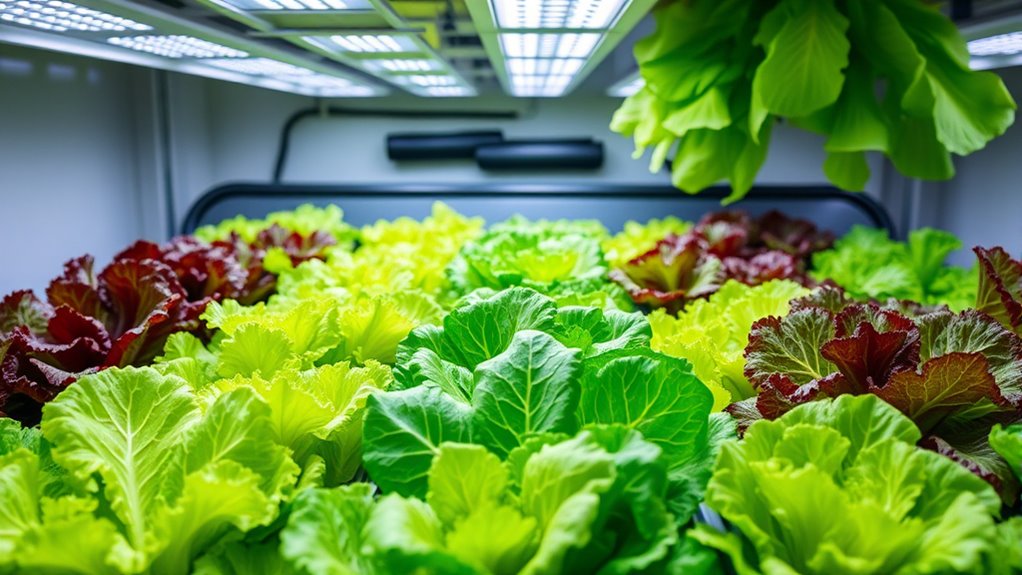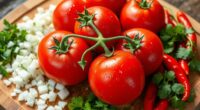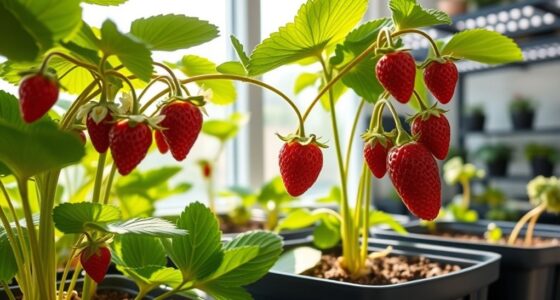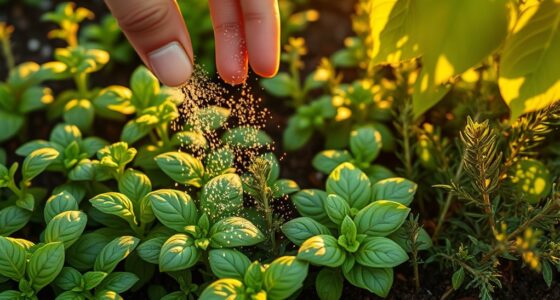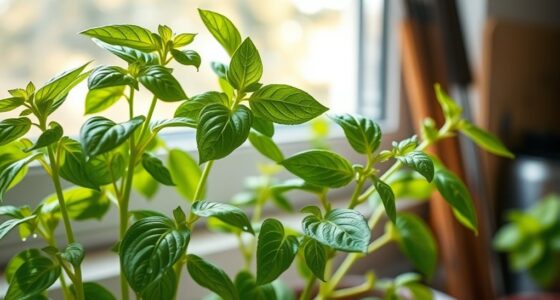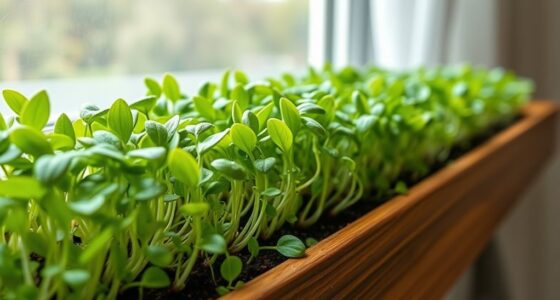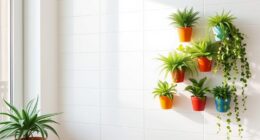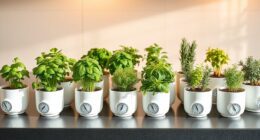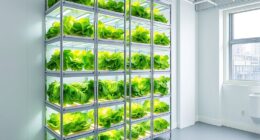For indoor hydroponics, choose lettuce varieties like Summercrisp, Little Gem, Salanova, Oak Leaf, and Forellenschluss, which resist bolting and stay tender longer. These greens adapt well to controlled environments, offering vibrant colors and crisp textures. Proper lighting, consistent moisture, and ideal temperatures help prevent bolting, ensuring a steady harvest. To discover more about cultivating these varieties successfully indoors, here’s how you can optimize your setup for healthy, continuous growth.
Key Takeaways
- Choose bolt-resistant varieties like Little Gem, Salanova, and Summercrisp for continuous indoor hydroponic harvesting.
- Opt for compact, fast-growing types such as Green Ice to prevent bolting indoors.
- Maintain consistent light (12-16 hours daily) and cooler temperatures to inhibit premature flowering.
- Ensure proper nutrient, water, and environmental management to promote healthy, bolt-free lettuce growth.
- Use tools like self-watering pots to maintain optimal moisture and reduce stress-induced bolting indoors.
Romaine Lettuce (Lactuca Sativa Var. Longifolia)
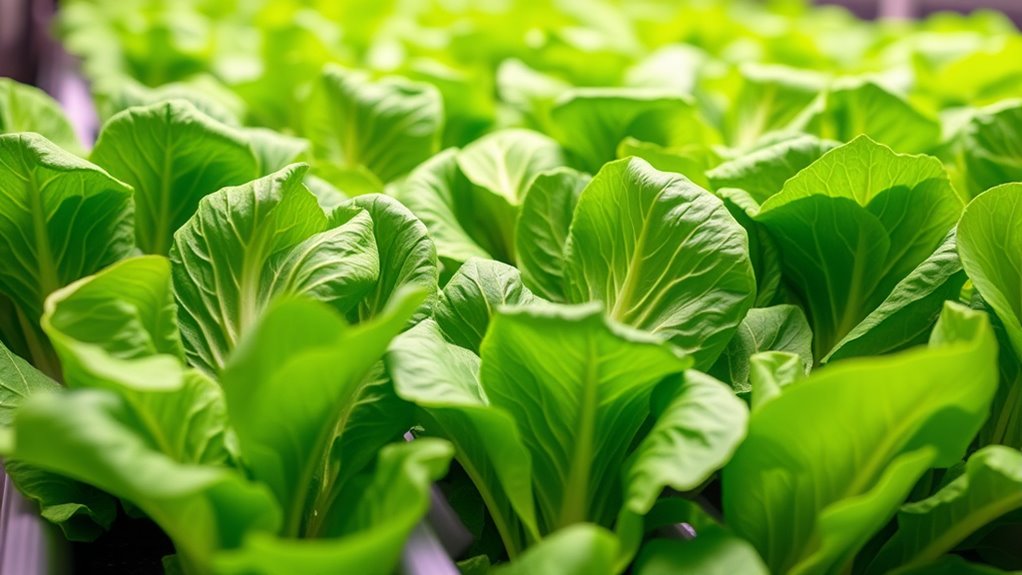
Romaine lettuce (Lactuca sativa var. longifolia) is a popular indoor vegetable known for its crisp texture and mild flavor. To grow it successfully indoors, you need to understand its nutrient requirements. It thrives with a balanced supply of nitrogen, phosphorus, and potassium, along with trace elements like magnesium and calcium. Regular fertilization ensures healthy growth and prevents deficiencies. Pest management is also vital; common pests such as aphids and slugs can quickly damage your crop. You should inspect your plants frequently and use organic controls or gentle insecticidal soap if needed. Maintaining proper humidity and airflow helps reduce pest issues and disease risk. Additionally, light quality plays a crucial role in healthy lettuce development, especially for indoor cultivation. With attentive nutrient management and pest control, your romaine lettuce can flourish indoors, providing fresh, crisp leaves throughout the year.
Butterhead Lettuce (Lactuca Sativa Var. Capitata)
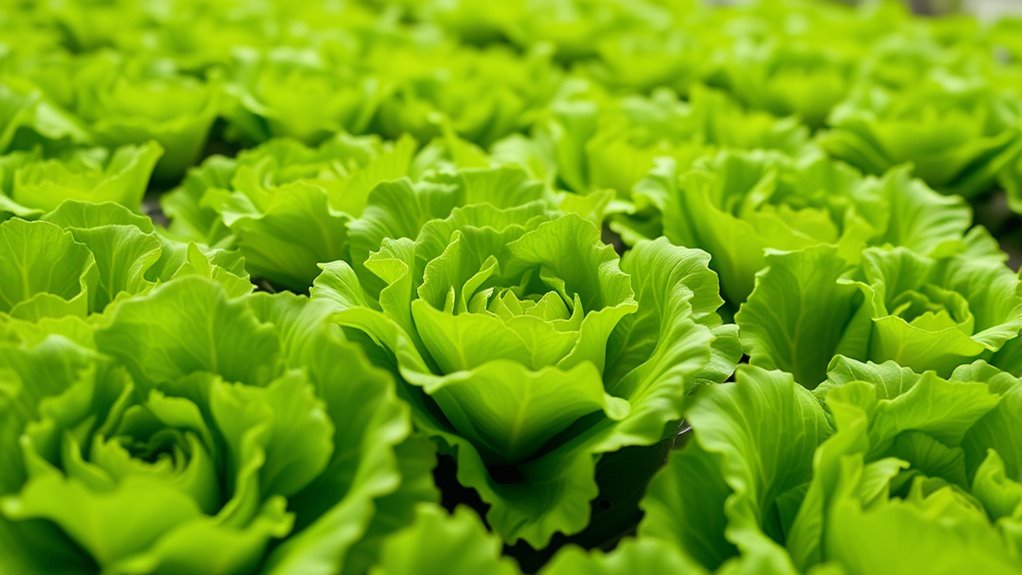
Butterhead lettuce (Lactuca sativa var. capitata) is a tender, leafy variety prized for its soft, buttery texture and sweet flavor. To grow it successfully indoors, you need to meet its nutrient requirements, especially nitrogen, for lush, healthy leaves. Consistent watering and proper light help prevent stress that can cause bolting. Pest management is essential; keep an eye out for aphids and slugs, and use organic controls when needed. Maintain good airflow and cleanliness to minimize pest issues. Maintaining optimal data privacy practices is crucial when managing digital tools for tracking plant health and growth. Butterhead thrives in slightly acidic to neutral soil or hydroponic solutions, so adjust your nutrient mix accordingly. Regularly monitor plant health to catch problems early. With the right care, you’ll enjoy crisp, flavorful heads of butterhead lettuce all season long.
Oak Leaf Lettuce (Lactuca Sativa Var. Crispifolia)
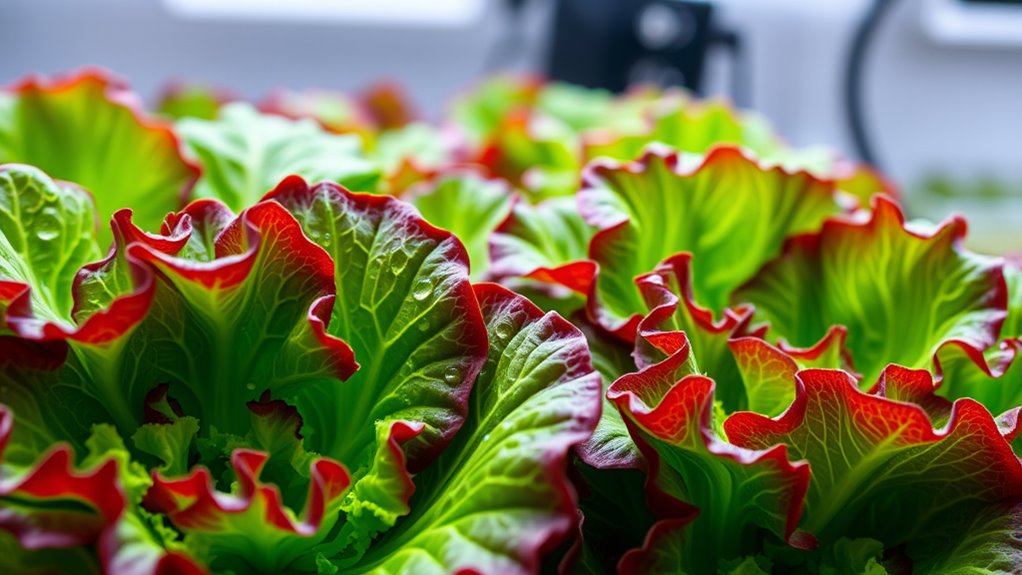
Oak Leaf lettuce (Lactuca sativa var. crispifolia) offers a beautiful, ornamental touch to your indoor garden with its distinctive, lobed leaves that resemble oak tree foliage. Known for its excellent pest resistance, it’s less prone to common pests like aphids and slugs, making it easier to maintain. This variety produces tender, crisp leaves with a mild, slightly nutty flavor profile that appeals to various tastes. Its ability to stay tender and flavorful without bolting makes it a reliable choice for indoor hydroponic systems. Plus, its attractive, dark green or reddish hues add visual appeal. By choosing Oak Leaf lettuce, you get a resilient, flavorful option perfect for continuous harvests indoors, ensuring fresh greens with minimal fuss. Additionally, its growth habit makes it suitable for compact hydroponic setups, maximizing space efficiency.
Summercrisp Lettuce (Lactuca Sativa Var. Capitata)
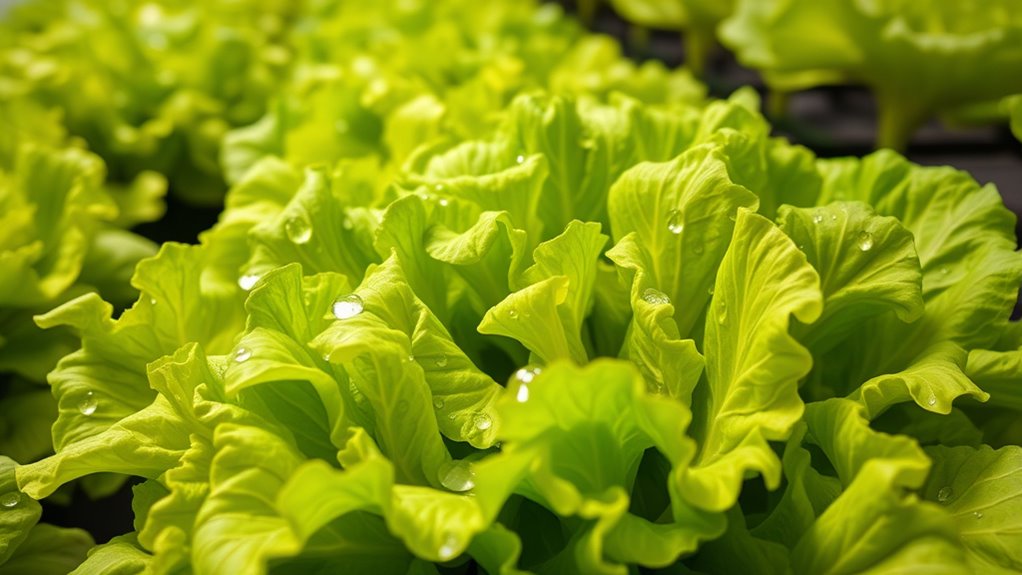
Summercrisp Lettuce (Lactuca sativa var. capitata) is an excellent choice for indoor gardening because of its sturdy, crunchy heads that provide a satisfying texture. Its summer heat tolerance helps it thrive even during warmer months, making it ideal for controlled environments. With strong bolt resistance traits, you won’t need to worry about premature flowering, ensuring a longer harvest window. This variety maintains crispness and flavor despite higher temperatures, making it perfect for indoor setups.
- Offers excellent summer heat tolerance for indoor growers
- Features strong bolt resistance traits, reducing early flowering
- Produces dense, crunchy heads for enjoyable salads and wraps
Little Gem Lettuce

Little Gem Lettuce is a compact, flavorful variety that’s perfect for indoor gardening. Its small size makes it ideal for container growing and quick harvests. To keep it healthy, you’ll want to meet its nutrient requirements by providing a balanced hydroponic nutrient solution rich in nitrogen, phosphorus, and potassium. Proper nutrition promotes crisp leaves and steady growth. Pest prevention is also essential; keep an eye out for common indoor pests like aphids and whiteflies. Regular inspection and maintaining good airflow help prevent infestations. Little Gem’s tight heads are less prone to bolting, making it a reliable choice for year-round indoor cultivation. With the right nutrients and pest control, you’ll enjoy fresh, crunchy lettuce without interruption. Maintaining optimal growing conditions is crucial for preventing issues and ensuring a healthy crop.
Red Leaf Lettuce (Lactuca Sativa Var. Crispa)
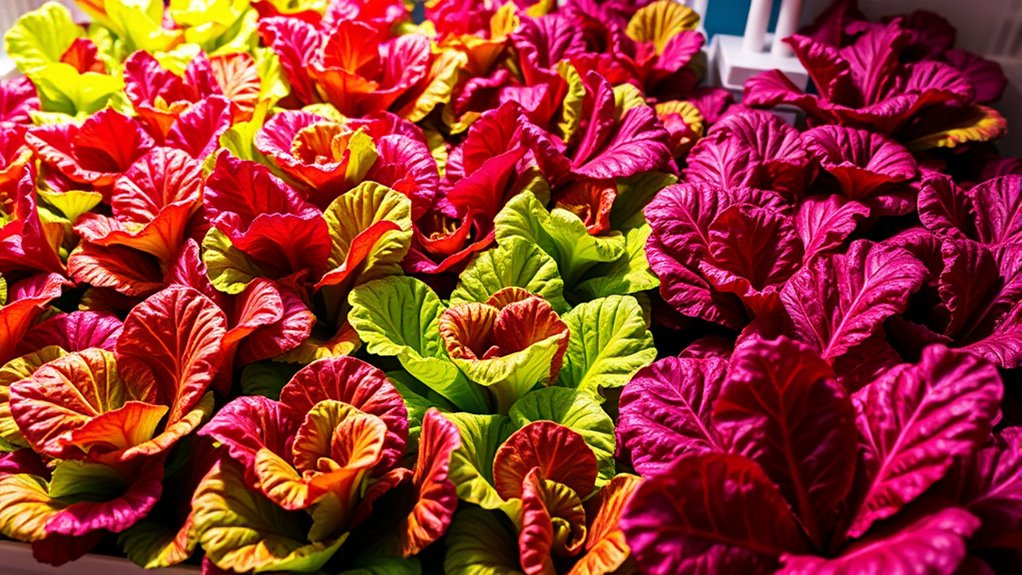
Red Leaf Lettuce (Lactuca sativa var. Crispa) is a vibrant choice for indoor hydroponics. It thrives with moderate nutrient requirements, especially nitrogen, iron, and calcium, which keep its colorful leaves lush and crisp. To prevent pests like aphids and slugs, regular pest management is essential; using natural predators or organic sprays helps keep your crop healthy. Additionally, choosing electric-powered grow lights can optimize growth conditions and ensure consistent light exposure. Guarantee consistent nutrient supply to promote steady growth and vibrant color. Monitor plants regularly for pest signs and act quickly. Maintain proper humidity and airflow to reduce disease risk. This variety prefers cooler temperatures and can bolt if stressed, so managing environmental factors is vital. With proper care, Red Leaf Lettuce offers eye-catching foliage and a reliable harvest indoors.
Green Ice Lettuce
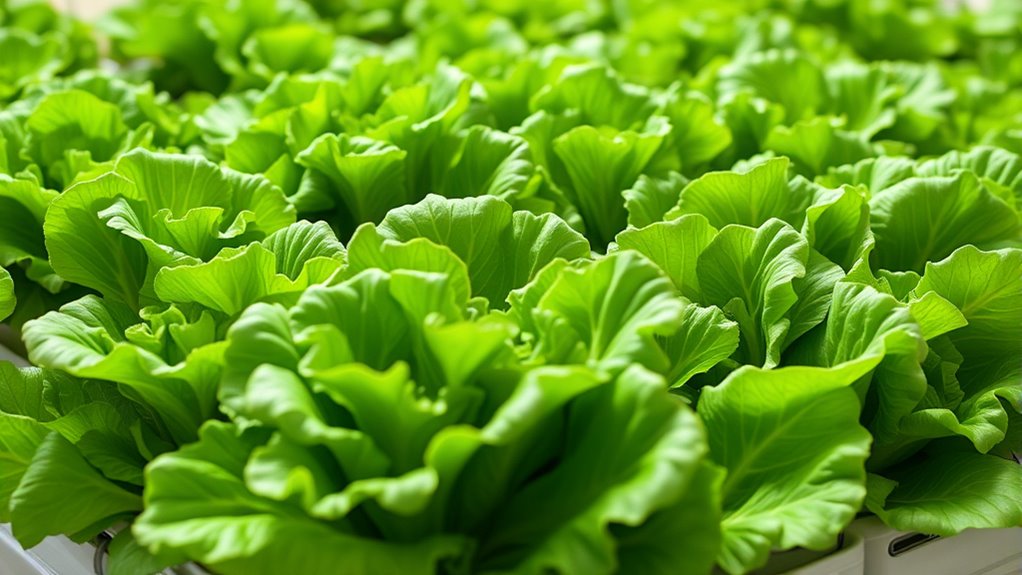
Green Ice Lettuce is an excellent choice for indoor gardening because of its fast growth and crisp texture. To keep it thriving, monitor soil moisture carefully—keep it consistently moist but not waterlogged. Ensuring adequate light intensity is essential; aim for at least 12-16 hours of light daily for ideal growth. This variety remains tender and flavorful without bolting, even in shorter day cycles. Its compact size makes it perfect for hydroponic setups, where controlled conditions enhance growth.
| Soil Moisture | Light Intensity |
|---|---|
| Keep moist but not waterlogged | 12-16 hours daily |
| Avoid overwatering | Avoid low light conditions |
| Maintain even moisture | Guarantee bright, consistent light |
Salanova Lettuce
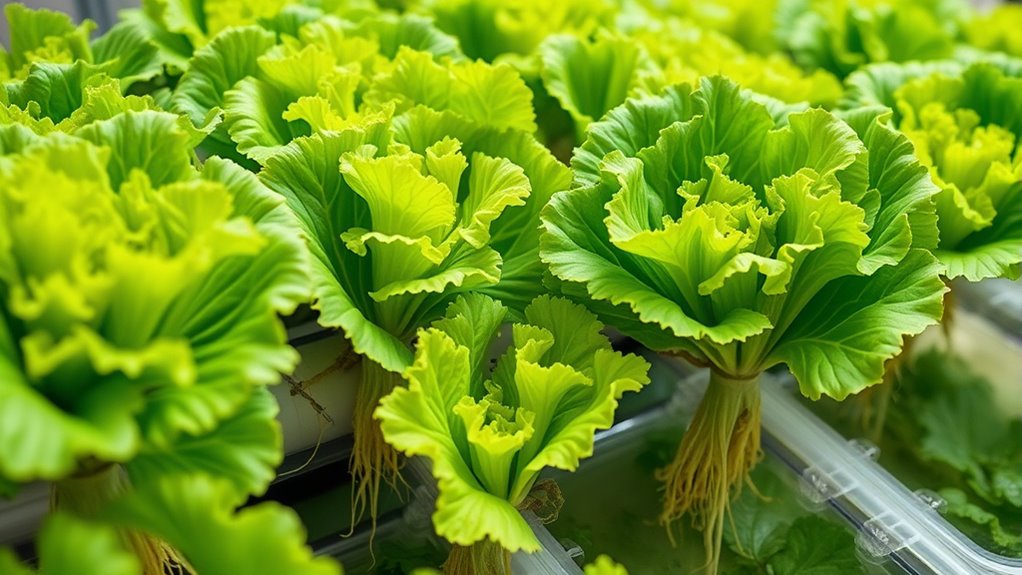
Because of its crisp texture and vibrant appearance, Salanova Lettuce is an ideal choice for indoor gardening enthusiasts. Its unique leaf structure makes it easy to harvest and adds visual appeal to your hydroponic setup. When considering salanova lettuce cultivation, you’ll find that it adapts well to container gardening and requires minimal space. The variety’s resistance to bolting ensures a steady supply of fresh greens without premature flowering. Choosing the right salanova lettuce seed varieties is vital—some are bred specifically to stay tender longer, even in warmer conditions. This makes them perfect for indoor environments. With proper care, you can enjoy continuous harvests of crunchy, flavorful leaves that brighten up your meals and your indoor garden.
Forellenschluss (Red Romaine)
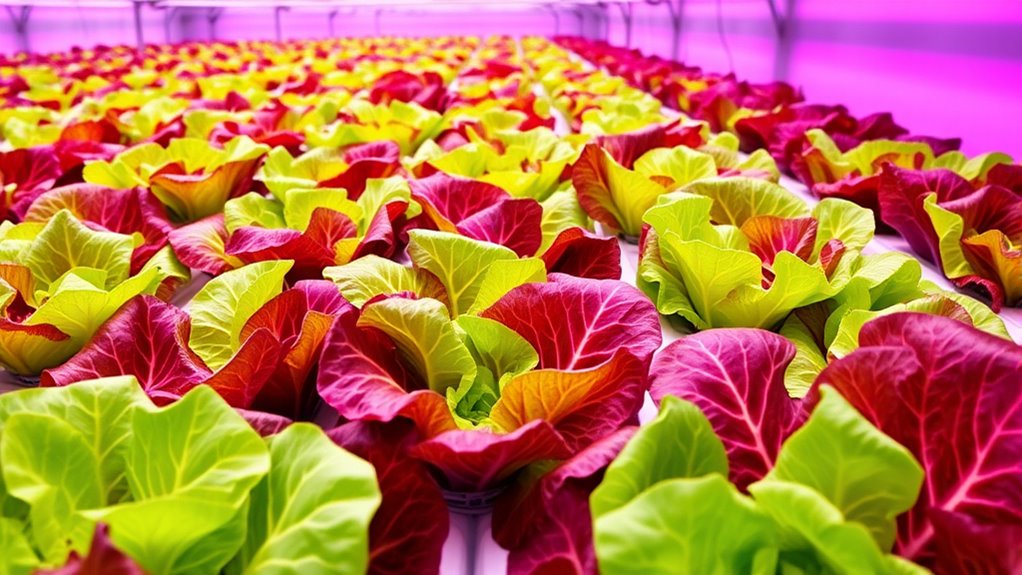
Building on the ease of growing Salanova lettuce indoors, Forellenschluss, or Red Romaine, offers a striking visual contrast and a crisp texture that enhances any home garden. To grow it successfully, use proper growing techniques like maintaining consistent moisture, adequate lighting, and ideal temperature. This variety is resilient and less prone to bolting, making it ideal for indoor cultivation. Pest management involves regular inspection for common pests such as aphids or slugs, and using organic controls when needed. Ensure good air circulation to prevent fungal issues. Self watering plant pots can be particularly helpful in maintaining consistent moisture levels for indoor lettuce growth. Forellenschluss’s vibrant red streaks add visual appeal, while its sturdy leaves provide a satisfying crunch. With careful attention to growing techniques and pest management, you’ll enjoy fresh, flavorful Red Romaine lettuce all season long.
Frequently Asked Questions
Which Lettuce Varieties Are Most Resistant to Bolting Indoors?
You’ll want to choose lettuce varieties resistant to bolting when growing indoors. Varieties like Romaine, Butterhead, and Leaf lettuce tend to delay bolting, especially with proper seedling propagation and consistent temperature control. Keep pests in check to prevent stress that triggers bolting. By maintaining stable conditions and selecting resistant types, you can enjoy a continuous harvest without the lettuce going to seed prematurely.
How Does Light Intensity Affect Lettuce Bolt Prevention?
You should know that light intensity greatly influences bolting in lettuce. By adjusting the light spectrum, especially ensuring ample blue light, you can delay bolting. Photoperiod control, or managing the length of daily light exposure, also plays a key role—shorter days typically prevent premature flowering. Maintaining ideal light intensity encourages healthy growth and helps you keep your lettuce tender and flavorful, without bolting too early.
Are There Specific Nutrients That Help Prevent Lettuce From Bolting?
Imagine your lettuce thriving, lush and crisp, not bolting as you tend your plants. You’ll want to guarantee they get the right nutrients—potassium and calcium promote healthy growth, preventing early flowering. Using soil amendments rich in these nutrients helps. Additionally, good pest management keeps stress levels low, which also delays bolting. Together, these strategies create an ideal environment for your lettuce to stay tender and flavorful longer.
Can Indoor Temperature Fluctuations Influence Lettuce Bolting?
You bet indoor temperature fluctuations can influence lettuce bolting. When temperatures vary, it stresses your plants, prompting them to bolt sooner. To prevent this, maintain consistent conditions by controlling humidity and keeping the root zone temperature steady. Using a thermometer and humidity monitor helps you stay on top of these factors, ensuring your lettuce stays tender and flavorful for longer. Stable conditions are key to preventing premature bolting.
What Are the Signs That Lettuce Is About to Bolt?
Like a knight sensing an approaching dragon, you’ll notice your lettuce giving subtle signs it’s about to bolt. Look for flowering signals, such as a tall, elongated stem emerging. The leaf texture also changes—becoming more bitter, tough, and less tender. You might see the plant stretching upward, with leaves that seem less lush. Recognizing these cues helps you harvest before the flavor and quality decline.
Conclusion
With these resilient lettuce varieties, you’re planting a garden that refuses to bow under pressure. Think of your indoor hydroponic setup as a fortress where these greens stand tall, unbothered by the season’s whims. By choosing these steady favorites, you’re nurturing a lush, unstoppable oasis—your personal green sanctuary. So, go ahead, cultivate with confidence, and watch your indoor garden flourish like a steadfast forest, no matter what the outside world throws your way.
